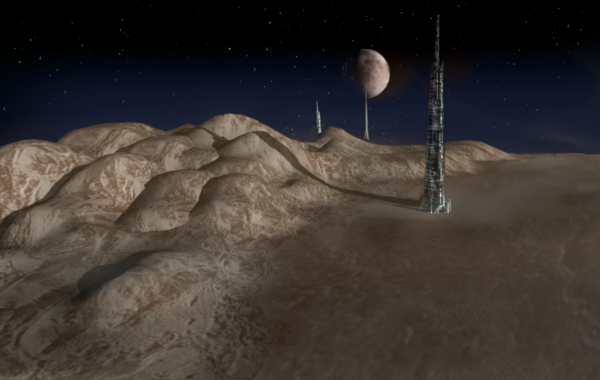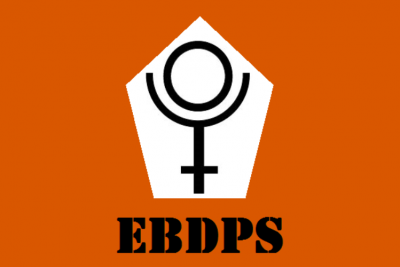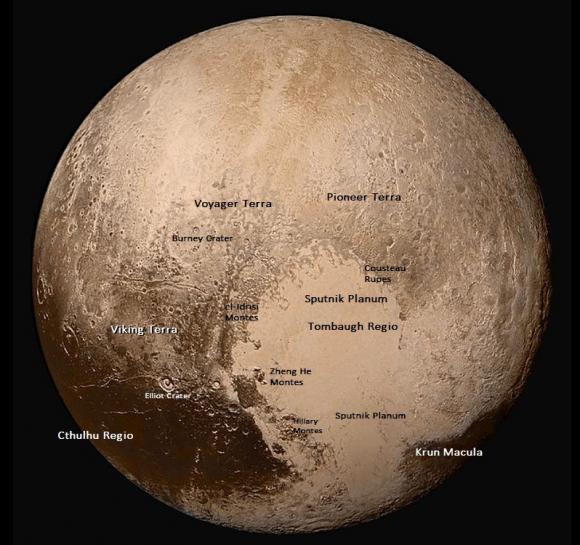BY LETTER
Pluto
 Image from Steve Bowers | |
| Arcologies on Pluto; in the distance the Pluto-Charon link can be seen. | |
Pluto -Data Panel | |
| System | Solsys |
|---|---|
| Planet Type | LithicGelidian Dwarf Planet |
| Aphelion | 49.305 AU |
| Perihelion | 29.658 AU |
| Diameter | 2,379.8 km |
| Density | 1.860 g/cm3 |
| Gravity | 0.063 g |
| Day :: Year | 153.36 hours : 90,560 days |
| Axial Tilt | 122.53 degrees |
| Natural Satellites | Charon, Styx, Nix, Kerberos, and Hydra |
| Polity Name | Plutonian Confederacy (PC) |
| Capital | Cyclopolis on Charon |
| AI overseers | No overall AI oversight however a number of Solsys Organization transapient entities maintain some presence. |
| Type | Confederation composed of a number of different polities collectively acting as a democratic constitutional representative republic. Constituent polities enjoy considerable autonomy at the local level and vary in government including cyberdemocracy, meritocracy, borderline freemarket anarchy, and others. |
| Symbol | PC Flag |
| Motto | We Govern Ourselves |
| Affiliation | The Solsys Organization : Out-System Development Alliance. |
| Population | 43 billion sophonts (8 percent nearbaselines, 18 percent low gravity tweaks, 3 percent cyborg, 9 percent space adapted humans, 11 percent vecs, 45 percent sophtwares, 6 percent other) live on or in orbit around Pluto and its several moons. |
| Major Population Centers | Newaldrin (largest city), Port Elizabeth, VirchCore395X, Novayasibir, Malagaski, Undertown |
| Economy | Mostly post scarcity free market |
| Currency | PC Credit |
| Major Industries | Volatile exports, trade and resupply station for Kuiper Belt, Beam rider hub |
| Angelnetting | Not common but found in some orbitals and cities |
| Travel | Beanstalks : Five to partial orbital ring, one to Charon Ground Transport: System of retro-historical maglev trains Beam Rider Network: Numerous boost beams, links to Solsys' wormhole. |
| Hazard Rating | Varies by location, usually range of 1.3 to 3.2 Visa Restrictions: None for the PC, some limitations depending on local polity |
| Sites of Interest | Intricate network of ice tunnels and caverns, Antarctic revival theme park, various relics from Old Earth and First Fed periods. |
History
The Early Years
Although in the same solar system as Earth, Pluto wasn't discovered until the early twentieth century. It was initially considered Solsys's 9th planet until reclassified as a dwarf planet several decades later. It is believed that the first unmanned probe to flyby Pluto was American and occurred in 2015 AD. Tradition holds that the first manned landing occurred in 290 AT by Arati Mhasalkar from the Republic of India. Nearly a century passed with only sporadic expeditions, until a permanent surface outpost was established in 381 AT by the United States of America. Named Lowell, it was a modest habitat situated near the Tartarus Dorsa ridge. Other nations and corporations soon followed. The European Federation constructed Skrymir Base on Viking Terra, Shuang Station on Charon was financed by a Syndicate of Chinese Provinces corporations, and the Corporate Republic of Indonesia built Pelabugan Dingin in orbit to name just a few. However, these settlements remained very small and by the advent of the Technocalypse only an estimated 17,000 sophonts lived in the Plutonian system.The Technocalypse and the Rise of the Directory
After the Technocalypse first erupted in the inner system in 565 AT, immigration soared as thousands attempted to flee to the supposed isolation induced safety of Pluto and its moons. While most tried to squeeze into existing habitats, many were staked claims of their own. This included New Aldrin Settlement, as it was originally known, on the shores of Sputnik Planitia which in time would grow into the planet's largest metropolis. Obviously named in honor of one of America's principle lunar colonies, New Aldrin became a sought after haven by refugees from Luna and the Belt. Another important refugee center was Malé Orbital which had a plurality of Maldivians and other South Asians. It is thought that in the first 10 years of the Technocalypse the population increased more than twenty-fold. As news worsened from the more developed parts of the system, various power brokers on Pluto became increasingly nervous of nanite contagion reaching their habitats. In 572 AT, a council of powerful Plutonian administrators established an Emergency Board of Directors for Public Safety (EBDPS). Quickly dubbed the Directory, it sought to sever all contact with the rest of the system in an effort to stave of the swarms. Clive Wongsuwan, the organization's first Director-General, was able to convince or coerce nearly all political groups to back measures for a strict self-imposed blockade and communication blackout. While a number of ships were turned away, often with fatal consequences, the quarantine likely saved Pluto and its moons from the worst of the Technocalypse. Image from MacGregor | |
| Directory Flag | |
Life under the Directory
Although authoritarian, it is important to note that the Directory was not a unified government at the beginning. Over the coming decades, the various micro-polities grew in size as they sought to scrape out a living on the small cold worlds. At this time, the various habitats were powered mostly by fusion reactors, as the flow of amat from the inner system had ceased and the distance from Sol limited the efficiency of solar cells. Despite these limitations, the Directory promoted pro-natalist policies to spur population growth. During the early 600's AT, Genetekker refugees largely using existing genemods launched the first serious attempt to gengineer humans to live comfortably on Pluto's low gravity. Known as Clade Morozko, this race of tweaks was not altered radically from other low-gravity clades but was designed to be more comfortable in cooler environments. This saved precious energy in heating habs. While Morozkos would remain a minority for the time being, they made up an increasingly high proportion of the surface and underground population. Over the next several centuries, life in the Plutonian system slowly but surely developed as new habitats were built. Due to the near complete isolation, a distinctive Plutonian culture focused on resourcefulness, civic pride, and technological conservatism arose. A creole of the various languages began to form and would eventually be codified into Plutoguese. Novayasibir Vodka became a popular beverage in many habitats. The Directory also grew to become ever more controlling and paranoid about preserving the quarantine, but life was still considerably less bleak than on other worlds in the Kuiper Belt such as Mary.The Uprising and the Fall of the Directory
Soon after the Federation of Sophonts was created in 933 AT, attempts were made to establish regular contact with Pluto and its moons. The Directory, then led by Rebekka Ruoho, tried in vain to prevent contact in hopes of preserving their monopoly on power. However, the sheer barrage of communications from the now vibrant renaissance occurring in the First Fed made this impossible. In 941 AT, what became known in Plutonian history simply as "The Uprising" began with a massive cyber-attack against Directory systems on the local net. Bombings, sabotage, and assassinations soon followed. In 944 AT, New Aldrin seceded from the Directory. When Director-General Ruoho ordered an armed crackdown, revolts erupted across a slew of habitats. By the end of the year, the Directory was dissolved and the first physical contact with the rest of Solsys occurred with the arrival of the federation ship Pride of Vesta. Image from Steve Bowers (from NASA public domain image) | |
| Pluto (before colonisation) | |
Pluto during the First Federation
Most of the various polities had joined the First Federation by 956 AT, and the Plutonian System's population reached nearly nine million sophonts. With the liberalization of communication and travel to the rest of Solsys, Pluto was soon inundated with new ideas, technologies, and people. Unsurprisingly, this caused friction with the older inhabitants. Many of the natives were especially wary of the AI and vec visitors and immigrants that began to arrive in force. Investment by inner system megacorps soon eclipsed many of the local organizations. A chief example was Port Elizabeth, by the standards of the time a giant Stanford torus, which first opened in 1102 AT. The Port Elizabeth Authority soon grew to become the largest single polity near Pluto and was populated mostly by near baselines and superiors from the inner system. The First Fed era was characterized by other large projects including a number of beanstalks and the first large scale worldhouses. Pluto and its environs became popular resupply points for Hiders and Haloists during the infrequent journeys inside of Federation territory. Despite some tensions between the various polities, the First Fed period was remarkable beneficial for development. Federation Anglic began to slowly replace Plutoguese in everyday use eventually relegating the language to ceremonial functions. Image from MacGregor | |
| Plutonian Confederacy Flag | |
Pluto and the Second Federation
At first, the PC refused to join the Second Federation preferring a looser association with the rest of the system. After several centuries however, attitudes began to thaw, and Plutonian society became more outgoing. Following considerable debate, the PC became a full member of the Second Federation in 2704 AT. For the first time, significant numbers of sophonts from other solar systems started visiting Pluto. Naturally, this unsettled some established elites but the influx of new ideas and technologies further drove development. It was during this time that most PC polities reached true post scarcity economies although workforce participation would remain higher than many other areas of comparable development. In 2877, the PC moved its capital from Newaldrin, as the metropolis was now known, to the new Charonian city of Cyclopolis. Designed to accommodate the various gravity tolerances of the PC's citizens, Cyclopolis had several large modules which rotated at different speeds to simulate the desired gravity. Some thought that the change in location of the capital also represented the growing clout of the Charon based Mechagen, a vec-run megacorps with a popular range of genemod templates and neogens (such as Charonian Kudzu) briefly made it one of the most powerful corporations in the system.The Inner Sphere Era
Pluto, like the rest of Sol Sys, became a safe haven for refugees fleeing the carnage of the First Consolidation War (3263 - 3435). While most would eventually resettle elsewhere, a number would become permanent residents adding their distinct cultures to the social melting pot. This process would repeat itself several times during the periodic conflicts between the growing archialect-led sephirotic powers such as the Version War (4464-4653) which even temporarily shut down the local wormhole links. Pluto joined the Solsys Organization after the collapse of the Second Federation. It was during this time, that Pluto's iconic retro-historical maglev train system was built. Named the Ninety, the maglev system got its name from its 1,000 kph speed which on the surface reduced the already week gravity by 10%. The PC hoped that the sleek maglev trains would help knit the various polities together both physically and politically. By the 52nd Century, the population of Pluto and its moons had swollen to 13 billion, this and the extremely long lifespans caused by widespread use of medisystems, prompted the PC to reverse itself and try and enforce stricter refugee quotas and promote anti-natalist policies.Post-ComEmp Era
In the two millennia following the dissolution of the Commonwealth of Empires (ComEmp), Pluto and its environs would alternate between long periods of stagnant stability punctuated by short eruptions of turmoil. The chief disruption during this period occurred in 6929 when the avatars of a mysterious S3 entity calling eirself Gracious Host appeared in distant orbit around Pluto. Gracious Host declared that e was now the ruler of Pluto and its moons, and effortlessly deflected any attempts by the PC and Solsys Organization to resist. Fortunately, GAIA quickly intervened destroying the Gracious Host avatars in a matter of minutes with what is believed to have been displacement cannons from the inner system. Unsurprisingly, there are a multitude of theories as to the origins of Gracious Host, the reasons for eir appearance, and GAIA's motivation for intervening. The anniversary of Gracious Host's defeat on Lavoisier 4 is still celebrated as Deliverance Day by most Plutonians.Outer Volumes Era to Present
Starting around 7800 AT, a new vitality sprang up on Pluto illustrated by the founding of the Out-System Development Alliance (OSDA) renewing Pluto's important role in the Kuiper Belt. In 8050 AT the first Lifelight, a sunline from the inner system, reached Pluto powering a large number of solar power arrays. This huge influx of energy helped fuel the creation of number of megaprojects. In 8444 construction of a massive space elevator, named the Bar, linking Pluto to Charon was begun. By the end of the 99th Century, a slender orbital ring with a distinctive gap for the Bar called the Horseshoe had been finished. These new projects allowed the PC's population to soar to 43 billion by 10,600 AT by far the largest of any location past the orbit of Neptune. In the current era, an increasing number of Plutonians have expressed interest in expanding the role of the OSDA or possibly leaving the Solsys Organization altogether but no concrete actions have been taken to date. Image from MacGregor | |
| Out-System Development Alliance Roundel | |
Back to Solsys
Related Articles
Appears in Topics
Development Notes
Text by MacGregor
Initially published on 09 March 2010.
Data panel and full history added May 2017
Arcologies on Pluto image by Steve Bowers updated 2024
Initially published on 09 March 2010.
Data panel and full history added May 2017
Arcologies on Pluto image by Steve Bowers updated 2024






